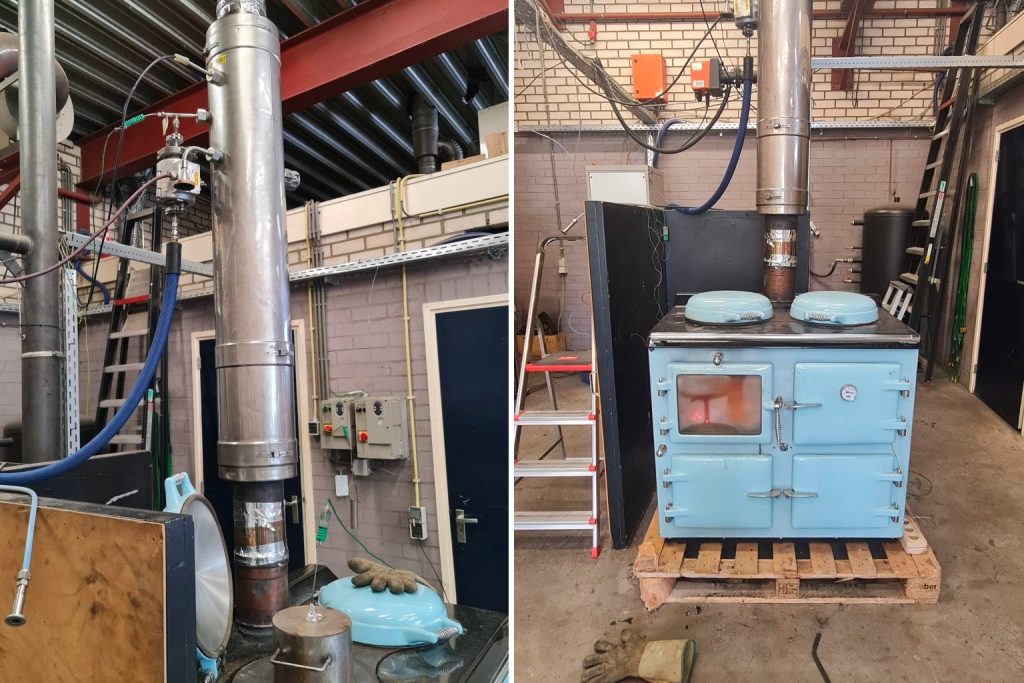The most Eco Fuel Efficient range now available…
The facts behind Thornhill’s Zero Carbon credentials…
by Graham Thornhill MD
If you want to go almost completely carbon neutral, then the cheapest, easiest way is to burn wood.
Let me explain.
Wood regrows in a lifetime, the Carbon dioxide released when burnt will be less than the CO2 absorbed when growing as the leaves fall each year and are turned to soil (carbon capture). And if the medieval system of coppicing wood is used, the cycle is a crop every 14-18 years, so most people with have 4-5 cycles in their lifetime.
One of the main objections to burning bio-fuel wood is the “pollution” produced by combustion, which enters the atmosphere.

New standards are constantly being enforced throughout the western world and the latest European ‘ECO Design Standard’ is extremely rigorous.
Having said that the my patented wood burning system achieved these designs 15 years ago in the wood stoves now manufactured nationally by Burley Ltd of Rutland.
At Thornhill, we always want to be world leader in design, so with already a very ‘clean burn’ we added a catalytic converter to further clean already clean exhaust.
With the Thornhill Cooker tested again to EU standards at an EU approved test laboratory, the results show in the picture below:

To measure exhaust particulates, a fixed volume of exhaust is pumped through a filter, the weight of the particulates can then be measured.
The black filter on the left of the picture shows a typical result from an Eco Design 2022 compliant stove. The other 2 examples are from the Thornhill Range cooker. IT PASSED
To take it one step further, I was curious to know what the carbon content of the exhaust was, so paid extra to the test to have the exhaust particulate chemically analysed.
The diagram below shows the results, with the finger pointing graphic on the line for carbon … fascinating!

Key points:
- Zero carbon P10 & P2.5 particulates, safe to burn
- 90.1% efficient, completely renewable fuel
- Takes out more carbon dioxide out the atmosphere than it puts back
- 30 mins to heat up to 180 from cold
- Uses just a 1.4kg log every hours
You can relax, sit and enjoy the infra-red heat and watch the flames with a very clear conscience that you are doing your bit and more for global warming… Plus for just a few £’s a year to run*
* (the cost depending on where you buy your fuel!!)
A great investment.
Oil & Pellet cookers:
With these 2 fuels, the Thornhill cookers run via a time clock, so you can set the cooker as you would your central heating. You can wake up to a warm kitchen without wasting fuel running the cooker all night long, off during the day then back on for you to come home to a warm kitchen and ready to cook. You can further reduce the heat output, so in spring and autumn you don’t waste heat over-heating the kitchen.
The result is the cookers only cost £2-400 a year to run depending on what you pay for your fuel. See the second explanation page if you are not sure how to calculate your costs.
Electric Cooker:
As with all makes of electric cooker, you do not want to use it for heating. Electricity is a very expensive way of buying energy, so all electric cookers are for on/off cooking only.
However, you can leave the Thornhill 3 and 5 oven electric models on low this will make the cookers warm to touch but not heat the room.
Note – this is totally different from heat pumps which are around 250% efficient and if you find the whole subject a bit muddling, please see below where I try to help explain some of the thing mentioned by government, energy, and appliance manufacturers.
Notes and explanations of energy, carbon neutral, usage & costs.
Let’s try and un-muddle some of the facts around this subject.
- Energy is measured in kWh, Joules or Kcal. ( BTU/hr if you live in America).
It is sold in completely different ways - Oil by the litre/gallon/barrel.
- Gas by the Therm, cubic metre, weight/kg’s or litres.
- Coal by weight in Kg or tonnes.
- Wood the worst of all: sold ‘by the LOAD’.
We need to know how much energy we need to heat our house to work out the cost of improvements.
So to do that the best way is to look at an old bill and work out the energy need of the house.
To do that we need to convert the way the energy was sold to use into kWh. We need to know the conversion factor for this.
| Kg CO2 per kWh | ||
| Heating Oil | 1 litre = 10.34 kWh | 0.24 |
| Natural Gas | 1 Therm = 29.3 kWh | 0.185 |
| LPG Gas Kg ( Bottles) | 1kg = 12.7 kWh | 0.21 |
| LPG Gas Ltr. ( propane) | 1 litre = 7.08 | 0.21 |
| Bituminous Coal House Coal) | 1kg = 8.39 kWh | 0.27 |
| Anthracite Coal ( smokeless) | 1 kg = 9.06 kWh | 0.25 |
| Wood | 1Kg = 4.9 kWh | 0.001 to negative |
| Wood pellets | 1Kg = 5 kWh | 0.005 |
| Diesel ( Gas Oil) | 1 litre = 10.7 kWh | 0.25 |
| Electricity | 1 kWh = 1 kWh | 0.193 2023 UK Gov |
So as an example:
if you used 1,500 litres of oil last year, you used 1,500 x 10.34 = 15,510 kWh/annum. This will vary year to year according to the weather, but not more than + or – 5%, just depends on the weather.
Carbon Footprint
If you want you can work out you carbon footprint now, you can do this by multiplying (in the example above) 15,510 kWh x 0.24 Kg = 3,722 Kg CO2.
A question I’m often asked – Why is Electricity so CO2 heavy?
Well although about 50% in the UK is generated by Wind, Solar, & Nuclear the intermittent nature of wind and solar means there has to be major back up of Gas, Oil & still some Coal, which is an inefficient use of these fuels if used for electric heating.
Why do the Government push heat pumps then?
Well the average heat pump in the UK output 2.5kWh of heat for every kWh. So if you want to know what it would cost for you to heat your house with a heat pump, using the same example as above ;
- 15,510 kWh per annum, divided by 2.5 if you have a heat pump, would mean an electricity bill of 6,204 kWh @ 24p/kWh = £ 1,489.00
- 2023 oil is 57p/litres so our example house costs 1,500 x 57p = £ 855.00/annum
- If you used electricity straight with out a heat pump, it would cost 15,510 x 24p = £ 3,722.00/annum. ( so please don’t believe the adverts for electric boilers!!!!)
Some customers are trying to claim that a house/family use different amounts of energy depending on what fuel they use.
This is of course complete nonsense, if you need 10 kwh of energy you need that much energy, direct from oil, gas, wood, coal or electricity or electricity via a heat pump.
You will need the 10kWh, just that you will only take 4 kWh of energy out the main electricity supply if you have a heat pump.
Wood energy: how to buy and explanation of Calorific values e.g. Amount of energy in a log?
Wood is a complex fuel, it consists of Carbon in the form of cellulose/charcoal and resins, which are complex hydrocarbons and WATER and a lot of it!
For example, when freshly cut, Wood is approx. 50% water.
Ash is the best to burn at just over 35% – that is why it is known as the Queen of Woods – and was always used for fires in the late Queen’s fires.
So a fresh cut 2 kg log holds nearly 1 litre of water and we have to get most of this water out of the log before burning as it will just smoulder, producing harmful carcinogens and high maintenance material such as soot.
The drying process takes 1-2 years after the wood is cut and split. It needs to be stored ideally in a covered place well ventilated place. Once dried the water content should be approx. 15-20%. Our 2 kg log will now weigh 1.25 kg approx. and have a calorific value of 6.125 kWh. ( calculated by the following (1.25 x 4.9kWh/kg)
So to extrapolate, if you purchased the wood by the Tonne the following example will help;
1 tonne of dry logs should be less than 20% moisture- that would be 625kg of wood at 20% or 3,000 kWh.
But wood is usually purchased by volume – usually the volume is based on the vehicle which delivers it. This is the loose stacked volume.
So take 1 cubic meter of loose logs, when stacked neatly will shrink to about .6 of a cubic meter.
The neatly stacked logs weigh approx. 0.6 tonnes, so the overall weight of say 3 cubic meters of logs loosely thrown into the back of a typical truck is 3 x 0.6 x 0.6 = 1.08 tonnes or 5,300 kWh.
If you typically paid £210 for a 3 cubic meter truck load that equates to 4p/kWh.
If you buy cheaper wet logs, you must stack them for at least 2 years or in a greenhouse or conservatory for 1 year approx. – they act as a kiln.
The author estimates on 3 cubic meters neatly stacked will produce a year’s fuel for a 5-8 kW Stove.
Happy to answer any questions on fuel so please email.



